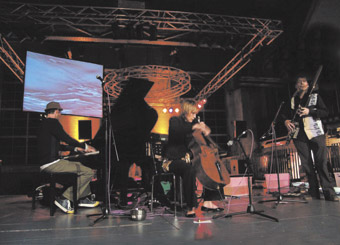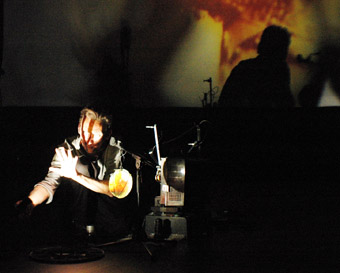sounds seen & worded
greg hooper at liquid architecture in brisbane

Erik Griswold (piano), Louise King (cello), Oscar Garrido de la Rosa (bassoon), Sounding Wivenoe, Liquid Architecture
photo Sharka Bosakova
Erik Griswold (piano), Louise King (cello), Oscar Garrido de la Rosa (bassoon), Sounding Wivenoe, Liquid Architecture
THE PERFORMANCE BEGINS WITH THE ROOM DARK, THE PERFORMERS SITTING ON THE STAGE FLOOR AMONGST OLD FILM PROJECTORS, REEL TO REEL TAPE DECKS, TUBS OF CHEMICALS, SPOOLS OF TAPE. TWO FACE THE AUDIENCE, BOUNCING THE PROJECTOR BEAMS OFF MIRRORS AND BACK ONTO THE SCREEN STRETCHED OUT BEHIND THEM, WHILST ANOTHER DOES THE SOUND. IT COULD BE A MEDIEVAL FAIR, RUGS ON THE GROUND, DIRT UNDERNEATH, MAGIC LANTERN SHOW. MACHINES BEGIN TO WHIR, UNSEEN FIELDS FLUCTUATE, ARE PICKED UP, AMPLIFIED AND PASSED ON. LENSES BLUR, HANDS CAST SHADOWS. FRAGMENTS FLICKER, CATCH AND BURN.
This is Cellule d’Intervention Metamkine, an extended cinema group out of Grenoble. Together for about 20 years their practice has moved from semi-organised narratives to completely improvised and spontaneous events.
There’s a visual structure to the performance—two squarish patches side by side, one for each performer, and a central circle overlay, frayed at the edges, not sure who controls it. It’s loud, soft, sharp, hard, tense, sometimes colourful, mostly not. Images flash like nervous memories of pathology reports, damaged retinas, further tests. An ending rushes toward us. Birds hovering, foam at the edge of the ocean. Manic gestures and found footage. The night-time glare of oncoming traffic and, after the crash, a silence.

Cellule d’Intervention Metamkine
erik griswold
Sounding Wivenhoe, by Erik Griswold, is set up on the raised concrete of the Turbine Stage. Wivenhoe is the major dam supplying Brisbane and, in the current drought, fast disappearing. On stage is a piano—excellently prepared in the Griswold style—and some lounge chairs for the audience to lounge in and have a beer whilst listening. Around the stage, on the mezzanine, and further afield, stand the other musicians—primarily brass and winds, but also a cellist up close to the piano. Plastic tubs of water and a few pots and bowls lie about—apparatus of the contemporary percussionist. A largish LCD screen is suspended high up and nearby, projecting video of the slightly rippled surface of Wivenhoe Dam throughout the performance.
Griswold starts playing high up the keyboard—fast tinkling arpeggios gradually extending in range. Over the top are occasional blurts from the wind and brass players, their lines also gradually extending as the piece moves along. Cello and bassoon play off each other, jazz fragments pop up on the side from trumpet, trombone and clarinet. Gradually the piano moves into hammered string sounds, then chills down to a sort of rubber harp. Performers echo rhythms and pitch fragments across the space.
In come the percussionists for the second section—gongs battered fast then pitch bent by dipping them into the tubs of water. The winds and brass sound out long drones. It’s like something out of a Kurosawa movie—mist and the pre-dawn, unseen armies slowly walking to slaughter. The drones drop out a bit and the gongs dominate again.
The third section begins with curiously maudlin melodies from the winds, like something sentimental from a Victorian music hall. Underneath and soft is Griswold’s weirdly flat-handed playing of the piano and busy arhythmic splats and clangs from the percussionists. The contrast works. There’s a jazz feel to the final section through the trumpet figure—Griswold composes neatly across genres and has a great feel for rhythm in his work. Finish on what sounds like sparse wind chimes.
The music sits well in the space, the performers acting as sound sources within an environment: obviously present but not obtrusive. Somewhat weaker is the projection of the video—not the images themselves, but the overt bounding of the image by the borders of the LCD. Where the spatial extent and arrangement of the sound sits naturally with the Sounding Wivenhoe theme, the LCD, with its hard, black, regular edges, is a bit lost in the volume of the Turbine Hall.
pauline oliveros
At about 75 years old Pauline Oliveros is a long-time name composer and one of the star attractions of this year’s Liquid Architecture. A major figure in the development of US music in the 1960s her scores are often invitations to behaviour and attention, such as “Listen to a sound until you no longer recognise it” (Re Cognition), or “Sustain a tone or sound until any desire to change it disappears. Where there is no longer any desire to change the tone or sound, then change it” (Horse Sings from Cloud).
Oliveros and accompanying vocalist, Ione, sit facing the audience. Oliveros starts on accordion, no pitch, just a slow voiceless wheeze as the lungs of the instrument push air in and out. Small close chords enter with the occasional rapid run synching up with a burst of consonants. A conversation builds, Ione singing along the intonation contours of speech, Oliveros playing accordion drones and rapid flourishes.
The second piece is a reworking of A Little Noise in the System from 1966, a classic of the genre that accepted the inherent noise of studio systems as worth a listen. This is an update, played live from Oliveros’ laptop. Small noise bursts move about overhead and, like the rhythmic breathing of the accordion, the spatial movement and pacing of the sound has the feel of human gesture. A bass drone rumbles in, volume quite low, building a rhythm that drops off, dies away. The noise ramps up until it’s frenetic, saturated and overwhelming. There’s a system going on, working its way out until the circuit is exhausted. Started great, but way too loud at times.
Back to accordion and vocalist for the third and final piece, this time with the accordion being electronically treated a little. The beginning is tiny clusters high up, simple single reed sounds with a little delay. Similar to the first work, but with the treatments articulating the accordion into complex little chirps to accompany the drones. Vocal and accordion gestures swap around, the words delivered deadpan with the occasional gliding pitch. The text recalls a time when the artist’s emotional autobiography seemed important. That’s not so obvious now.
Liquid Architecture 8: Cellule d’Intervention Metamkine, sound Jérôme Noetinger, projectors Christophe Auger, Xavier Quérel; Sounding Wivenhoe: composer, prepared piano Erik Griswold, video Rebecca Ross, musicians Richard Haynes, Miranda Sue Yek, Elliott Dalgleish, Oscar Garrido de la Rosa, Dan Quigley, Crystal Hildred, Louise King, Vanessa Tomlinson, Matthew Horsley, Wang Yan, Paul Lin; Pauline Oliveros, composer, accordion, laptop with vocalist Ione; Brisbane Powerhouse, July 6-7
RealTime issue #80 Aug-Sept 2007 pg. 51






